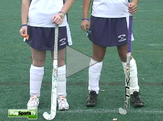PlaySportsTV Field Hockey
Coaching Field Hockey Transition Skills

Transition required skilled field hockey players.
By Anthony Coleman
PlaySportsTV Contributor.
Veteran field hockey coach Traci Davis feels the success of transition concepts in girls' field hockey depends greatly on two key factors.
“It really depends on the playing surface,” says the field hockey coach of the successful Garrison Forest School program in Owings Mills, Md. “We are fortunate to have a synthetic surface which allows for crisp, clean passes. On a bumpy grass field, you may not be able to do things like long passes.
“Also, which strategy we use depends on our opponent and our perceived weaknesses of the opponent. I take into account what I feel our team needs to work on, its strengths and weaknesses."
The former All-American at Ursinus College (for field hockey and lacrosse) coached her team to the IAAM `A’ Division title in 2007 and was named the Baltimore Sun Field Hockey Coach of the Year. She was a member of the U.S. women's lacrosse team for 10 years and a player at the U.S. Field Hockey Olympic Festival in both 1981 and 1982.
Davis prefers her field hockey players to go wide as they move toward the goal. She also preaches reversing field at some point during the transition. After a turnover, Davis likes for her field hockey players to use a combination of short and long passes.
“The middle of the field tends to be clogged with players,” Davis says. “So your best bet is to bring the ball up the field wide. With a reverse of the field, you can catch a team at a disadvantage. Most teams have their strongest defenders or overload with defenders on the strong side (ball side), so if you reverse field, you most likely will have open space to attack the offensive circle."
Davis feels the reverse of field should come between the 35-yard lines. In addition, she stresses to girls’ field hockey coaches that the reverse of field doesn’t have to be achieved through a forward pass. A back-pass (if on a synthetic field) could help achieve this aim.
Transition is one of the advanced aspects of field hockey which Davis doesn’t introduce to players until late middle school or early high school. Her school runs camps and clinics for players beginning in the second grade. In order to be successful in transition, it takes skilled field hockey players, from the defense to the attackers.
Once a defender gains possession, she has to be aware of her options and the field hockey skills to execute the transition. While big hits are an option, Davis is fond of soft passes as the best way to advance the ball. Give-and-go passes between players are one of her favorites.
To work on the first concept, Davis uses the entire field during field hockey drills. Starting at the defensive end to the left of the cage, Davis will have her team work with no defense. The first player will pass the ball to a player about 16 yards ahead of her on a slight angle (just not parallel to her). The second player will dribble to about midfield on the left side. At about midfield, she will send a crossing pass to the right side and about 10 yards ahead of her (again, just not parallel).
The third player will then dribble some 10 yards before passing to a fourth player ahead of her. The fourth player will take the ball to the right of the cage and send a centering pass through the circle where the second player (who sent the reverse-field pass and continued to run up the field in helping with the transition) attempts the deflection on goal.
After practicing this with no defense, Davis will add defenders at each station and have them play at 50 percent (light pressure) before allowing her field hockey players to go 100 percent.
In practice, Davis divides the field hockey field into grids – eight-yard boxes at various spots. She will have two offensive players with one defender in each grid. The two offensive players have to get the ball past the defender and advance the ball to the next grid. To do this, the teammates have to work together, using give-and-go or buddy passes.
Once this is achieved, one of the offensive players will send a crossing pass to the other side of the field to the next grid, where the process is repeated.
Davis believes players advance their field hockey skill level though transition because it requires the use of finesse passing. It also requires players to have good field vision and excellent field hockey stick skills.
The offensive player may have to dodge a defender to make the crossing pass. She has to be able to hit and push the ball while on the move. Plus, the field hockey player on the receiving end of the crossing pass has to be able to stop the ball without much deflection, which develops soft hands.



